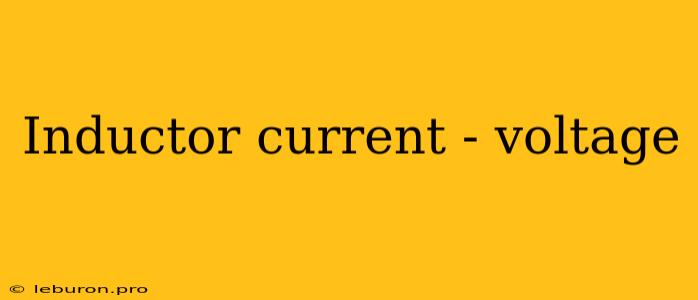Inductors are passive electrical components that store energy in a magnetic field when current flows through them. They are essential components in many electronic circuits, playing a crucial role in filtering, energy storage, and signal processing. Understanding the relationship between inductor current and voltage is fundamental to effectively utilize these components in circuit design. This article delves into the intricate connection between inductor current and voltage, exploring key concepts, equations, and practical applications.
The Fundamental Relationship: Lenz's Law and Faraday's Law
The relationship between inductor current and voltage is governed by fundamental laws of electromagnetism: Lenz's Law and Faraday's Law. These laws describe how changing magnetic fields induce electromotive force (EMF) in a conductor, which manifests as voltage across the inductor.
Lenz's Law states that the induced EMF in a conductor due to a changing magnetic field opposes the change in current that caused it. This principle ensures that energy is conserved as the inductor stores and releases energy.
Faraday's Law quantifies the relationship between the induced EMF and the rate of change of magnetic flux. It states that the induced EMF is directly proportional to the rate of change of magnetic flux through the inductor. The magnetic flux is directly proportional to the inductor current, thus creating a link between inductor current and voltage.
The Inductor Equation: Connecting Current and Voltage
Mathematically, the relationship between inductor current and voltage is represented by the following equation:
v(t) = L * di(t)/dt
Where:
- v(t) is the voltage across the inductor at time t
- L is the inductance of the inductor, measured in Henries (H)
- i(t) is the inductor current at time t
- di(t)/dt is the rate of change of inductor current with respect to time
This equation clearly illustrates the direct relationship between voltage and the rate of change of inductor current. A higher rate of change in inductor current results in a higher voltage across the inductor, and vice versa.
Inductor Behavior in Circuits
Understanding the behavior of inductors in circuits is crucial for effective design.
Inductor Behavior in DC Circuits
In a DC circuit, where the inductor current is constant, the rate of change of current is zero. According to the inductor equation, this means that the voltage across the inductor is also zero. In essence, an inductor acts as a short circuit in a DC circuit once the current reaches a steady state.
Inductor Behavior in AC Circuits
In AC circuits, the inductor current is constantly changing, leading to a varying voltage across the inductor. The inductor's behavior in AC circuits is characterized by its reactance, which is a measure of its opposition to current flow. The inductive reactance (XL) is directly proportional to the inductance (L) and the frequency (f) of the AC signal:
XL = 2πfL
A higher frequency AC signal leads to higher inductive reactance, implying stronger opposition to current flow. In AC circuits, inductors act as filters, blocking high-frequency signals while allowing low-frequency signals to pass through.
Applications of Inductors
Inductors find numerous applications in electronics, leveraging their ability to store energy and their relationship with inductor current and voltage. Some key applications include:
Energy Storage
Inductors can store energy in their magnetic field. This property finds applications in power supplies, where inductors are used to smooth out DC output voltages and minimize voltage ripple.
Filtering
Inductors are used in filter circuits to selectively pass or block specific frequencies. This is particularly useful in audio systems, where inductors are used to filter out unwanted noise and distortion.
Signal Processing
Inductors are also used in signal processing circuits, such as oscillators, amplifiers, and transformers. Their ability to react to changing inductor current makes them valuable for manipulating and shaping signals.
Practical Considerations
When working with inductors, several practical considerations are crucial:
Inductance Value
The inductance value determines the inductor's ability to store energy and its reactance in AC circuits. Choosing the appropriate inductance value is essential for optimal circuit performance.
Current Rating
Every inductor has a maximum current rating. Exceeding this rating can lead to overheating and damage to the inductor.
DC Resistance
Inductors have some internal resistance, which can affect circuit performance. This resistance can cause power dissipation and voltage drop across the inductor.
Frequency Response
The frequency response of an inductor refers to how its reactance varies with the frequency of the AC signal. This aspect is crucial when designing circuits for specific frequency ranges.
Conclusion
The relationship between inductor current and voltage is fundamental to understanding inductor behavior in circuits. Lenz's Law and Faraday's Law govern this relationship, explaining how changing magnetic fields induce EMF across the inductor. The inductor equation provides a mathematical expression for this connection. Inductors play essential roles in various applications, leveraging their ability to store energy, filter signals, and shape circuits. By considering practical factors like inductance value, current rating, and frequency response, engineers can effectively design and implement inductor-based circuits for a wide range of applications.
